
Normally we would start with a little description of the source material, but for this project I will leave that to Craig Ferguson:
If you have not seen Doctor Who I strongly recommend you take some time and catch up with the new series (2005 and newer, aka the 9th, 10th, and 11th doctor series) not just because it is a good show, but because pretty much anybody you meet at a sci fi convention has seen the show, so you have to be a little bit familiar if you want to hold a conversation.
There are several reasons I decided to build a Dalek. The main one I’ll share is that during the first two Dragon*Cons we’ve attended we saw how popular the show is, but we never saw a high quality, screen accurate Dalek, and I figured it would go over well for D*Con 2012. Additionally, I found out in the fall, just as I started to watch the show, that there would be a local Doctor Who convention here in Huntsville in early June. The only question left was which Dalek to make. There are two versions seen in the modern series; the 2005 series and the 2010 “colorful” Daleks. Many fans do not like the newer ones, but the reason I did not make that one was practicality: between the height and the width, it would not fit in a van or through doors. By process of elimination, I went with the 2005 version.
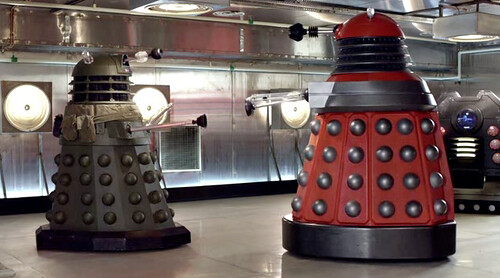 ,
,2005 Series Dalek (Ironside paint scheme) on the left and a 2010 Dalek on the right.
Cosmetic:
The project started off by downloading plans from the Project Dalek web site. Note that while these provide some of the outside dimensions, the build process is totally up to the builder, and I will point out some of the dimensions are wrong. First, the skirt and bumper were built up using ¼” plywood and reinforcing the seams with fiberglass mat. The outer seams were filled with bondo and the entire assembly covered in Elmer’s wood filler and sanded smooth. You may note my bumper is missing the ledge seen on the show Daleks. This is intentional as the ledge would have made the Dalek too wide to get in and out of standard doors and the elevators in the Marriot and Hyatt.


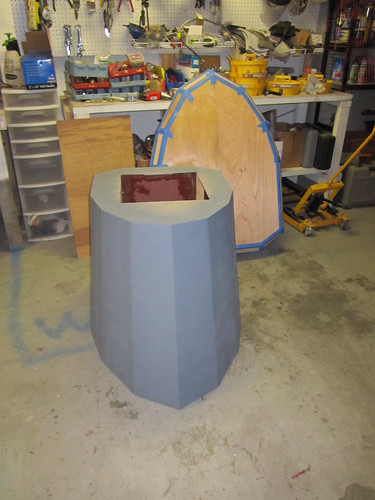
With the base shaped, the next step was the shoulder section. I started off by outlining the top and bottom of the structure with plywood and added temporary supports to hold the pieces at the correct offset. Poster board was then glued to the outside and the entire inside reinforced with fiberglass mat. After the assembly was smoothed with Bondo, the gun mount blocks, made from plywood, where added and reinforced with fiberglass. The outer edge details were created using ½” thick foam insulation, then sealed with paper mache and covered with bondo. The bottom ring received a ring of balsa to reach the correct thickness and provide a little stronger support.

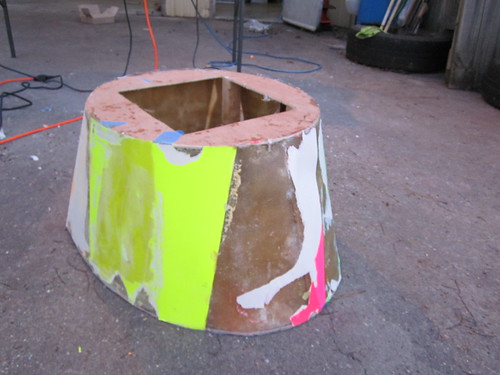
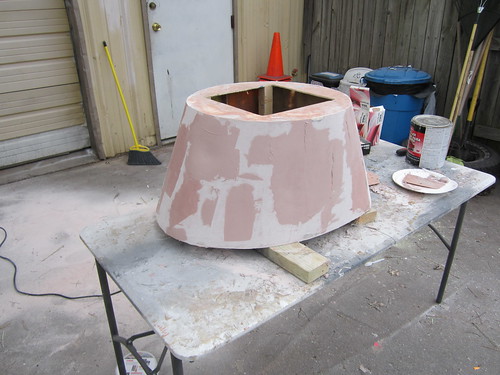

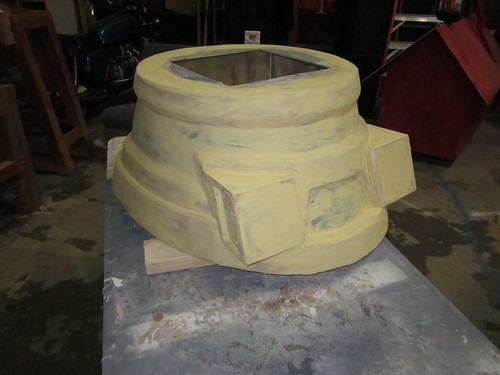
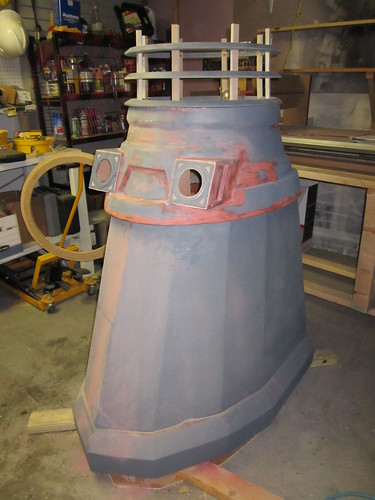
The slats that go around the shoulder section are fiberglass castings. There are only three sizes, with each original made from plywood. A curve gauge was used to measure the contour of the shoulder section and trace it onto the slats so they could be cut and fit properly.
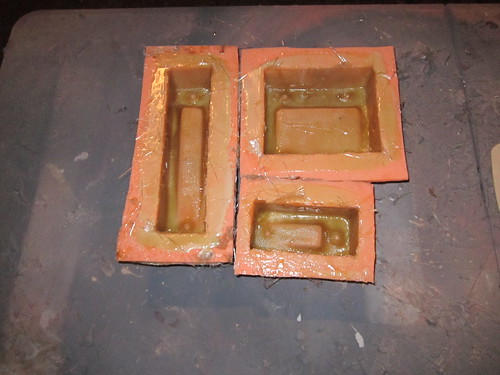
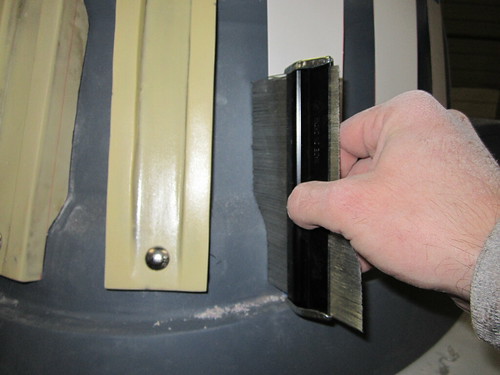
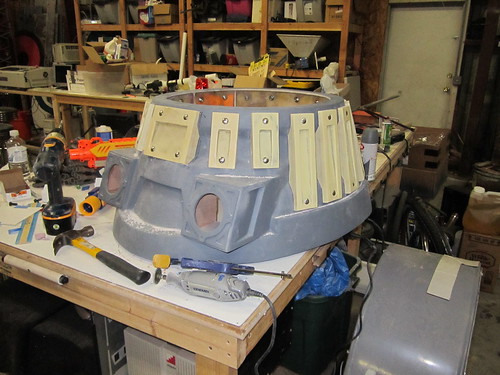
I don’t like routers, so the neck rings were each made from two pieces of MDF glued together and then filled with Bondo to create the proper beveled edge. The three rings were then connected and screwed to 8 MDF supports. The support detail was shaped from balsa, molded and then 24 copies were cast from Smooth Cast 300. The inner neck structure is a MDF frame painted black, then covered with window screen and anti-slip floor mat.
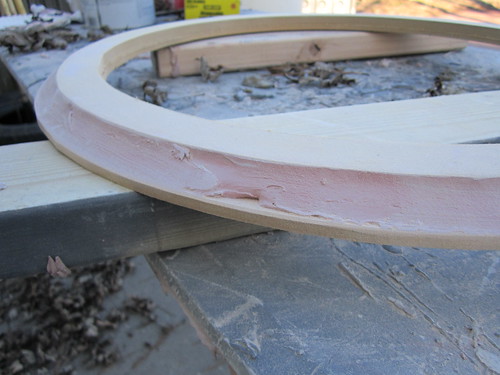
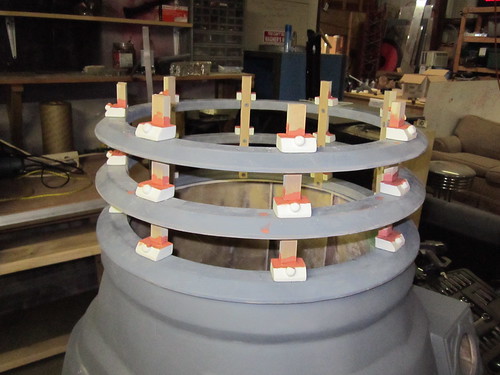
The head started off as a pepakura file designed by Dave. He then glassed it, built it up with bondo, and carved the details into it. The dome lights are MOFLASH lens covers, which are the same model used on the real BBC Daleks. The cage that goes around them was sculpted from wood and cast in resin.
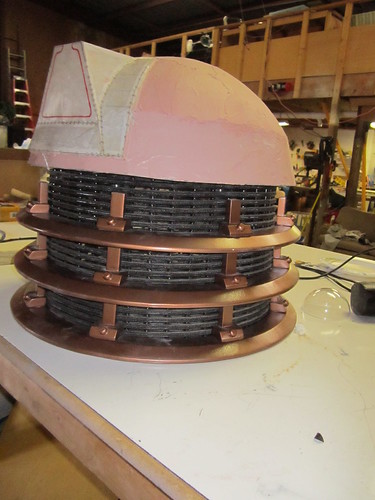
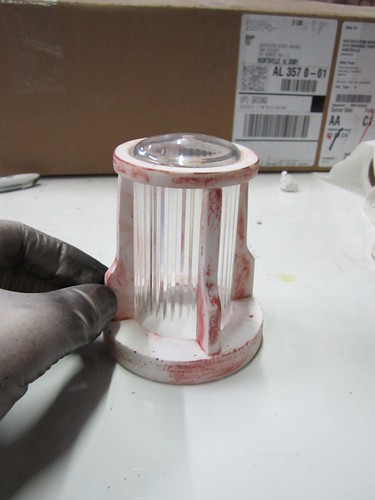
The eye was made using a laser cutter. Several circles were cut out, stacked, and glued to form the “socket” of the eye. The rest was built up with wood and bondo. The rings behind the eye were shaped from MDF, then molded and cast and affixed to an aluminum tube with epoxy.
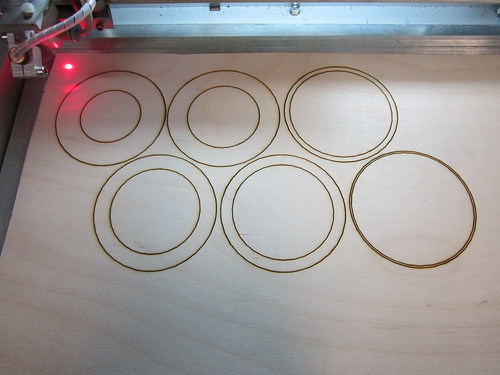
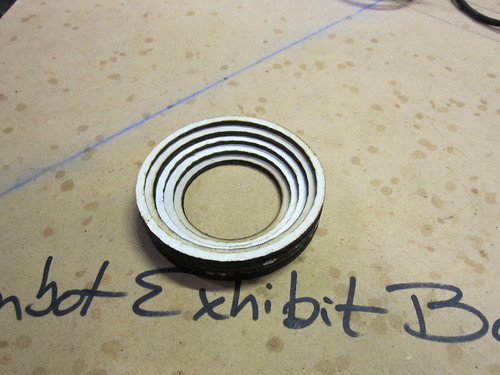

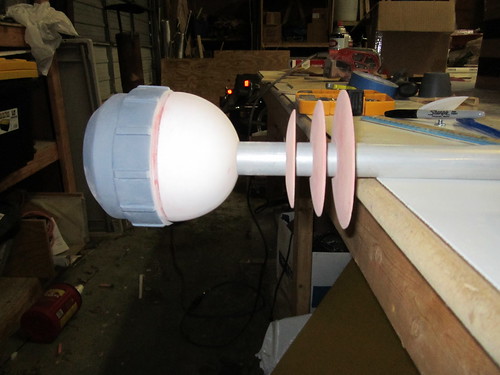
The each hemisphere on the skirt is 3 separate pieces. The ball is a 4” acrylic ornament ball you can find at most hobby stores, although I ordered bulk online as I needed at least 30 of them. The ring that goes around the ball was first made from MDF with a circle cutter, then molded and cast in Smooth Cast 300. A support disk was made and cast such that is gives the hemisphere a surface to hold to and plugs into a 1.25” hole on the skirt for proper alignment. The plastic was trimmed and sanded, the support glued in, the ball ring painted, then joined together and glued to the skirt. This had to be repeated 56 times!
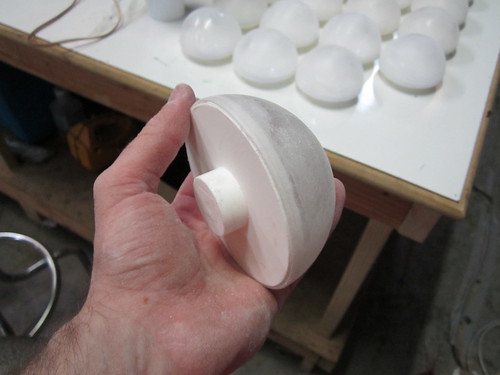

One interesting observation was made while casting the rings and supports. Without using any mold release, the molds started to show wear around casting 35 and then “died” around casting 55. Prior to this project, our friend Volpin posted that his Thomas mold crapped out at about 75. I’m not sure what the maximum lifetime achievable of a mold is, but if you need a lot of castings be sure to use a release agent and keep your master positive just in case.
Many people use plungers on their Daleks, which is not accurate as the actual prop is made from various plastic parts available in England. I made a screen accurate version using a 110mm acrylic ball and apoxie sculpt for the raised detail. The support is made from wood and PVC pipe. The laser gun includes aluminum pieces machined by a co-worker from 6061 aluminum. Both “arms” are mounted to 4” balls reinforced with Onyx resin.
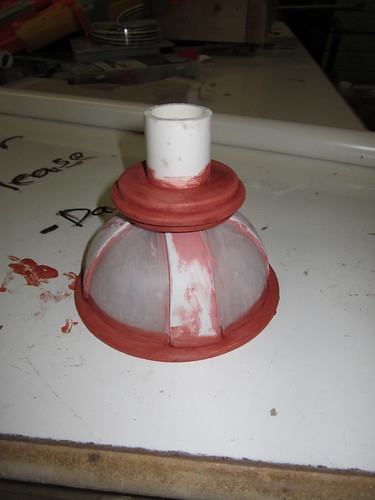
The laser arm consists of two pieces of 6061 aluminum machined by a fellow coworker. The whisk parts were made using an MDF jig and bending each rod to the desired shape. The entire assembly was then glued together with epoxy.

The entire Dalek was painted with Krylon hammered copper paint, flat black, and Rustolum gold. This may be the last project I use Krylon on because the metallic paint kept jamming on me. If I ever repaint the Dalek I’ll use more of a brass color, but nobody has ever mentioned anything about the color to me and I think it still looks okay.
Electronics:
A disclaimer before I start. I am NOT an electrical engineer. I am a fluid dynamics and rocket propulsion engineer. I spent several months researching battle bots, R2-D2s, and electrical safety in general (particularly wire gauges for amperage). Additionally, my electronics are changing as I learn more and increase the Dalek’s capabilities. This post reflects the state of electronics at Dragon*Con 2012.
The base of the Dalek uses 2 wheel chair motors that were donated by Dan Valdez of the Steampunk X-Men. I made an aluminum base to hold the motors in place and give the bumper about 1.25” clearance from the ground. These motors are powered by two large 12 VDC (volts direct current) batteries wired in series to provide 24 volts. The motors have a safety feature of an electronic brake that requires an applied voltage of 24 VDC to allow the wheels to turn. Power is regulated to the wheels via a Sabertooth 2x60 dual motor speed controller which mixes the receiver signal, allowing me to steer with one stick (more on that later). The speed controller is turned on and off using a heavy duty 24 VDC relay, allowing me to turn the motors on and off with a small switch from the outside. All the wires, including those for the head and receiver batteries, are zip tied together and run as an umbilical to the mid-section.

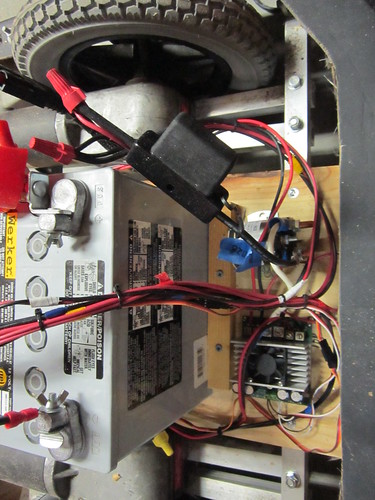
In the shoulder section is a junction board running power to the various components and hooking up to the exterior switches. The switches allow me to turn on the sound, brake, main motors, head motors, and transmitter from the outside. The switches are hidden with a magnetic panel on the outside. The board also houses a Sabertooth 10 speed controller for the head, which uses a 12 VDC geardown motor, a relay allowing me to kill power to the motors using the controller, and a 6 channel receiver for the remote. The main motors take 2 channels, the head takes 1 (currently), and 1 is used for the safety relay.
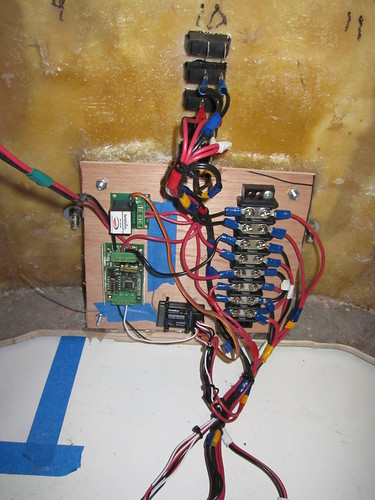
Sound is currently achieved using a sound chip and car speaker. If you remember this post where I added sound to my proton pack, this is pretty much the same thing. There are 10 sound effects recorded on the chip, with each connected to a relay on a 12 channel remote board. Using the transmitter, I can play a specific sound on the chip through a 20 watt amplifier and 5.5” car speaker. I also built a ring modulator to distort my own voice, but it requires a pre amp and won’t be installed until a later date.
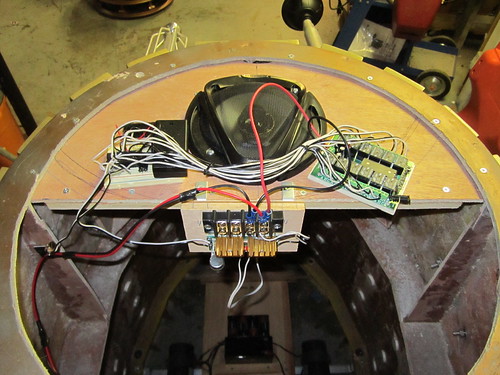 ,
,The controller on the right is the controller I use to operate the Dalek. The right stick controls the main wheels. The left controls the head, and the channel 5 switch is the kill switch. The transmitter velcroed to the side controls the sound effects. The controller on the left is an old school model I originally used that burned out on me and caused a lot of headaches.

The Dalek made its first appearance at Con Kasterborous in Huntsville, but it was not motorized yet. It was also empty enough that I still could fit a person inside. Once the wheel chair motors and sound were installed, I lost this capability and the Dalek became fully a remote controlled prop. He got an unbelievable reaction there and even ended up on the local news.
His first motorized appearance was Dragon*Con 2012. While David and I have always gotten a pretty good response from people when we take our projects out in public, the response this thing got was intense. There was not a single second someone was not taking a picture of the Dalek, and many people gave me compliments along the lines of, “This just made my Dragon*Con” and “You won the convention”.
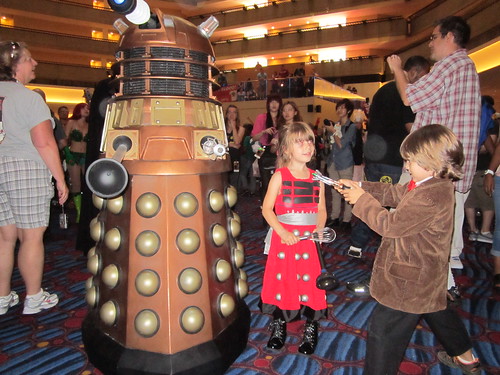
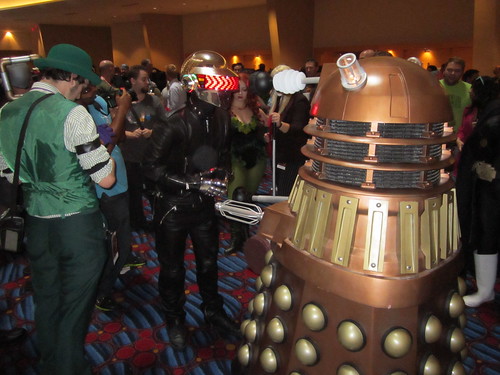
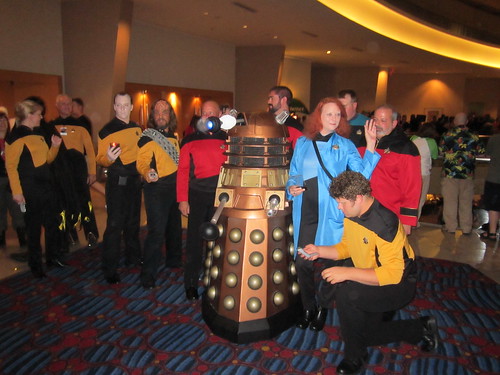

Since the Dalek cannot hold a person I could not enter him in the Friday night costume contest, so I put him in the Masquerade Sunday night instead. The skit was the Dalek was cosplaying as the scariest thing he could think of, which of course is the Doctor. His “costume” consisted of a Tom Baker scarf and a cheap fedora I found on eBay. We recorded a skit with the voice modulator, and took home an award for Best Sci Fi. I will post a video of the skit as soon as I can find one.
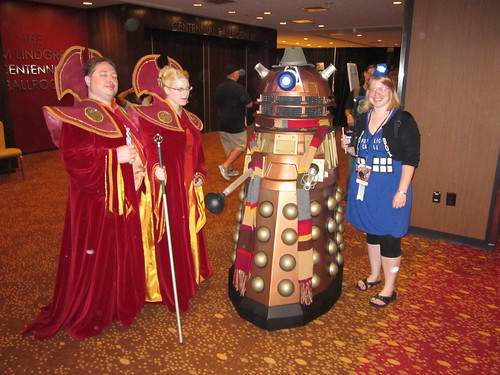
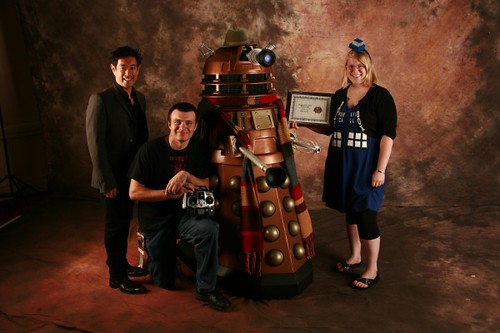
This project has had a lot of ups and downs, but the reaction was great and I am pretty sure I’ll be taking him back next year with a few upgrades such as having his eye move up and down and installing the voice modulator so I can talk through him in real time. If you missed him his year and can’t wait for D*con 2013, he is tenitavly scheduled to appear at Charger Con 2012, and will be at Con Kasterborous in Huntsville this June and possibly Yuri’s Night at the Space and Rocket Center in Huntsville in April. If you know of any other events you would like us to bring him, or any of our projects, to please send us an email at 2StoryProps@gmail.com
Finally, this project took a lot of people to complete in addition to myself and David, so I want to give a shout out to a few people who made this possible.
Dan Valdez for the wheel chairs.
Chase Yarwood for advice on the control system.
Mark Wells for machining the laser arm parts.
Tim Heath for letting me tear apart his scooter, borrow his van, and record the skit audio.
Amanda Mangan for kitting the Dalek’s scarf.
Jennifer Paulsen for being the fake operator/ victim in the masquerade skit.
And the folks on project dalek and the R2builders forums.
Stay tuned for an upcoming write up on David’s cheese head and an updated version of our portal gun!

Fantastic! I do love the Dr. Who TV series. It's always pushing the limits of the imagination. Great work on the Dalek, it really is spectacular!
ReplyDeleteWonderful job!
ReplyDeleteDo you think the colorful Daleks would be big enough to install the wheel chair motor assembly and still fit a person?
Thanks for sharing your journey! I find it fascinating (and incredibly wonderful!) to see what you have done. It was great to meet you in person at Con Kasterborous 2013!
ReplyDeleteThis was my favorite part of Dragoncon 2012. I also loved the Apollo costume this year. Thanks for sharing these wonderful posts. I look forward to seeing them again or seeing whatever else you have in the works.
ReplyDelete